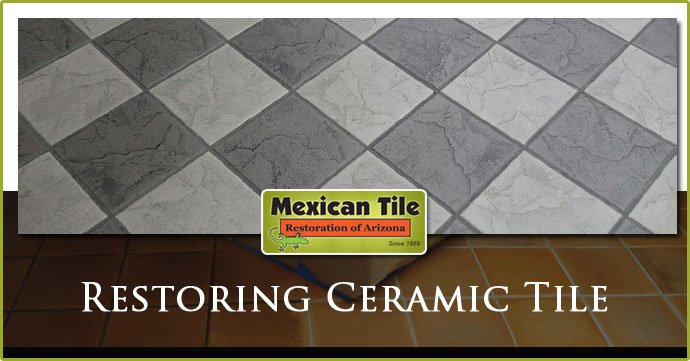If you own a property that has ceramic tile, it will need to get restored and cleaned occasionally. This Guide to Restoring Ceramic Tile will help you understand the steps to cleaning tiles and replacing tiles which have cracked or broken. Regular cleaning will rarely get stained and/or dingy ceramic tile completely clean. If harsh abrasive cleaners are used, they are not going to restore the ceramic and will leave an etching which only gives a dull appearance to the surface.
However, acidic cleaners that have been specifically formulated just for ceramic will get the dirt out without leaving that etching and without damaging tiles. Of course, even after cleaning thoroughly there may be a few tiles which could use a little more work in order to correct any cracks and/or chips. A more inexpensive way to go about restoring a ceramic floor would be to replace the tiles individually, if getting them back to their original condition is what you’re looking for.
Removing Ceramic Tile Stains
- First you will need to tape off the baseboards, bottom of cabinets, and appliances with masking tape.
- The tiles should be swept to clear all dirt and debris from the surface, not forgetting about under the edge of the cabinets and corners and also any other areas that collects dirt.
- Next, you have to mix a combination of water with the acidic ceramic cleaner concentrate in a container, referring to the instruction of diluting. This is due to different manufacturers may give different instructions for doing this.
- Now, mop the floor good with this cleaning solution and do not overlook the little areas. It is best to use a handheld brush or else a deck broom while scrubbing the solution onto the tiles, this helps in the removal of soil that has built up for a long time.
- After the using the solution to clean the floor the bucket needs to be filled with fresh clean clear water to rinse the solution up, changing water as needed.
- It’s time to get a clean towel and wipe the floors dry. After which the masking tape can be removed, and the baseboards and appliances have to be wiped down with a clean cloth damp towel for the removal of any residue left behind and could have made contact with them.
Replace Damaged tiles
Using moderate pressure, scrape the tool referred to as a carbon tipped scorer all around the damaged tile, and keep doing this until all of the grout has been removed. You should place some painters tape around the tiles adjacent to all tile being replaced, as this will replace those tiles during the replacement process.
With a power drill, make ¼ inch holes in tile, spacing them ½-1 inch apart, making sure they are an equal distance from one another.
Take a ¼ inch chisel and put under the tile at a 90-degree angle, tapping lightly in order to loosen and gently lift the tile up adjusting the angle to a 45 degree when the tile is being lifted. Do this same thing until all tiles are removed. The chisel can now be used to get up the tile adhesive that remains.
Now apply ¼ inch layer of the tile adhesive with a notching trowel, and now you will apply a second layer of the adhesive on the back side of the tile you are using for the replacement.
Make certain that the tile is centered as it is being placed and firmly press down. All you do at this point is let it dry for two hours.
Place the grout over the grout float and spread on all of the joint lines that go around the tiles while keeping the float at a 45-degree angle from the surface. Let this dry for 15 minutes. Using a damp sponge, the grout haze around the tile needs to be wiped off. The floor should be left to dry for a complete 24 hours before you do the final cleaning up or before it is walked on.
The following is a list of the things you are going to need:
- Acidic ceramic cleaner
- Masking tape
- Towel
- Mop
- Mop bucket
- Sponge
- Broom
- Scrub or deck brush
- Carbide-tipped scoring tool
- Painter’s tape
- Hammer
- Notched trowel
- Drill
- Tile adhesive
- Grout
- Grout float
- Chisel
- Goggles
Tile Cleaning & Restoration Safety
Should the grout have a dingy appearance to it can be cleaned with a solution of diluted chlorine bleach. In order to prevent the occurrence of a dangerous chemical reaction, be certain that all the cleaners used for cleaning the tiles prior to the tile replacement have been cleaned up entirely.
Warnings:
- You need to protect your baseboards and cabinets because the acidic ceramic cleaner will damage them.
- It is important that you wear protective glasses while removing the tiles to keep any debris from getting into your eyes.
Professional Ceramic Tile Restoration
If you don’t have the tools, time, or desire to restore and clean your ceramic tile yourself, Mexican Tile Restoration is here to help! Our team has a wealth of experience cleaning all types of tile including ceramic. We will bring your ceramic tile floor back to life and looking new with our highly detailed and thorough ceramic tile floor restoration service!
Schedule ceramic tile cleaning today by calling 602-370-6082
